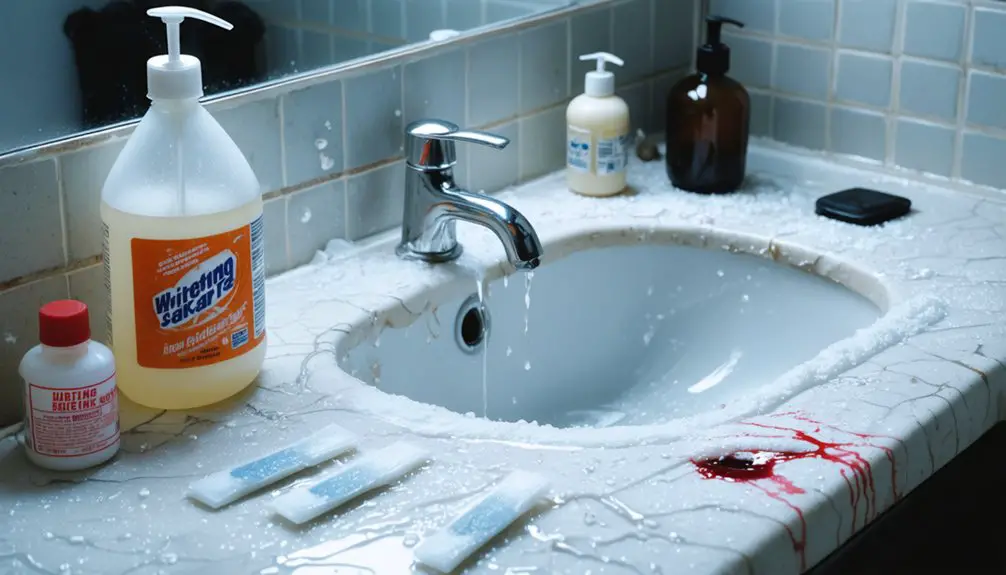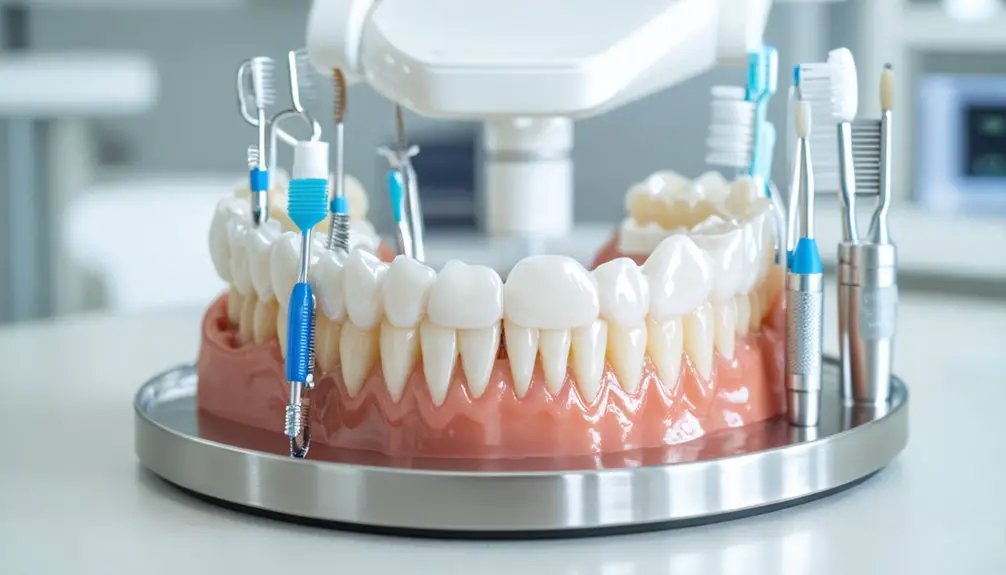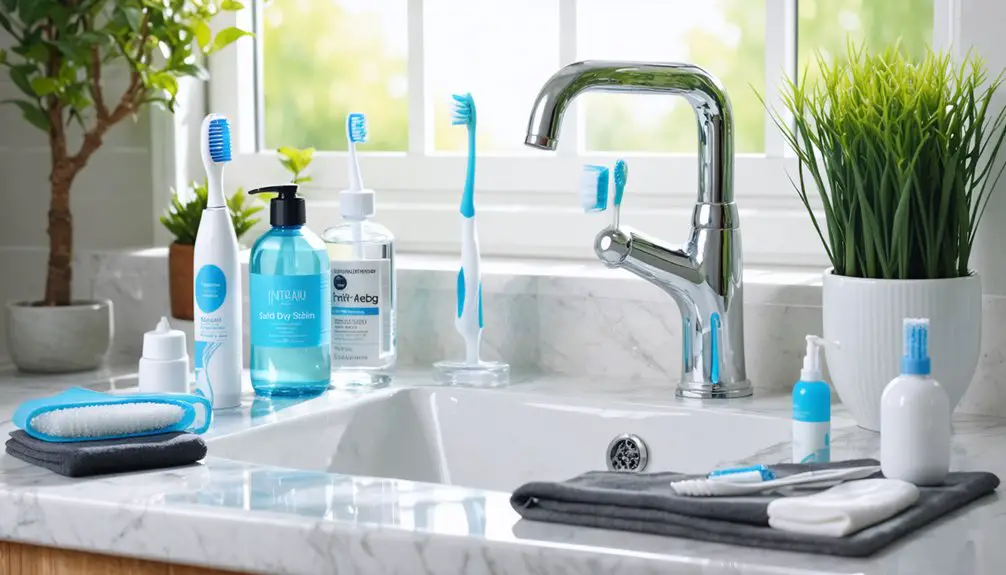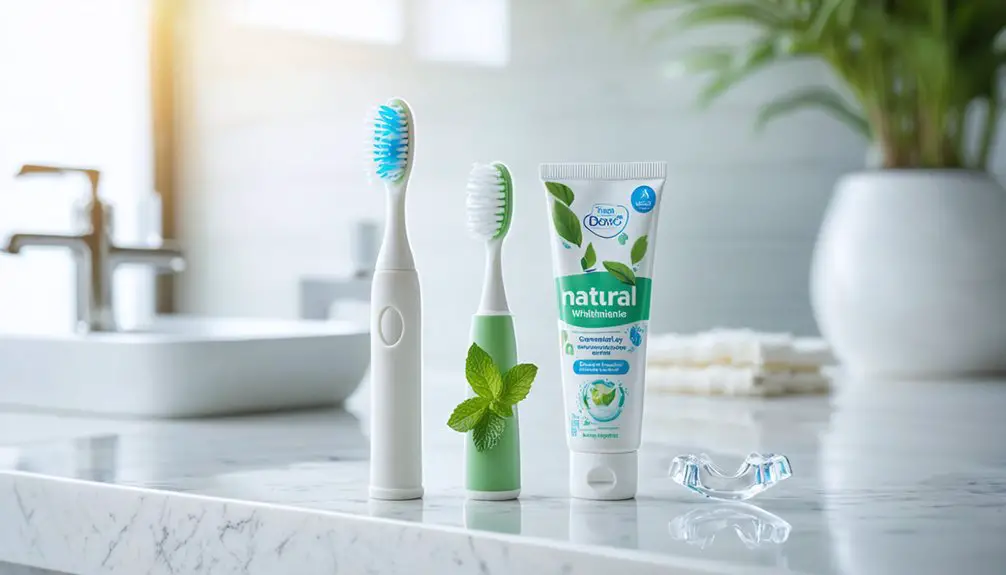DIY teeth whitening methods can permanently damage your tooth enamel, which won’t regenerate once compromised. You’re risking chemical burns to your gums, uneven coloring, and heightened tooth sensitivity from unregulated products that may contain dangerous levels of hydrogen peroxide. While these methods cost less initially, they often lead to expensive dental repairs. Professional treatments offer safer, more predictable results under expert supervision. Understanding the full scope of risks will help protect your long-term dental health.
Key Takeaways
- DIY whitening products can contain dangerous levels of hydrogen peroxide, up to 110 times the legal limit, causing chemical burns.
- Improper application and ill-fitting trays can lead to gum inflammation, recession, and increased risk of infection.
- Uncontrolled use of whitening agents can permanently damage tooth enamel, which cannot regenerate once compromised.
- One-size-fits-all treatments often result in uneven whitening and may not work on existing dental work like crowns.
- DIY methods can cause severe tooth sensitivity by exposing dentinal tubules through microscopic openings in weakened enamel.
The Hidden Cost of Enamel Erosion

While the allure of a brighter smile drives many to pursue DIY teeth whitening, the potential damage to tooth enamel presents a serious concern that shouldn’t be overlooked.
Your tooth enamel, once compromised, can’t regenerate itself, making prevention vital for long-term dental health.
Protecting your enamel is crucial – once it’s gone, it’s gone forever. No amount of dental care can bring it back.
Common whitening agents like hydrogen peroxide are known to penetrate and break down stains, but can also weaken enamel structure when misused.
When you use whitening products too frequently or at high concentrations, you’re risking permanent enamel erosion.
While natural enamel remineralization techniques can repair minor damage, continuous exposure to bleaching agents can overwhelm this protective process.
That’s why following whitening product guidelines is imperative – treatments shouldn’t exceed once every 6-12 months.
The consequences of ignoring these limits include increased tooth sensitivity, yellowing from exposed dentin, and greater susceptibility to decay.
Professional supervision guarantees you’ll achieve whiter teeth without sacrificing your enamel’s integrity.
Fluoride treatments can help strengthen and protect your enamel after whitening procedures.
Gum Health Complications and Risks
Although the quest for whiter teeth drives many to try DIY solutions, these treatments pose significant risks to gum health that can’t be ignored.
When you apply unregulated whitening products, you risk chemical burns from high concentrations of hydrogen peroxide, leading to painful inflammation and swelling. These injuries can trigger lasting gum recession, exposing sensitive root surfaces to further damage.
Without professional supervision, DIY whitening methods frequently result in improper application and excessive gum exposure. The American Dental Association strongly recommends avoiding unsafe at-home whitening methods. Long-term use of whitening strips and gels can cause persistent redness and swelling of gum tissue.
The chemical and mechanical trauma from ill-fitting trays or strips can compromise your gum barrier, making you more susceptible to infections and periodontal disease.
Over time, persistent irritation may develop into chronic conditions like gingivitis or periodontitis, potentially causing irreversible tissue damage that affects both oral function and aesthetics.
Understanding Tooth Sensitivity Issues
Beyond gum health risks, tooth sensitivity ranks as one of the most common complications of DIY teeth whitening.
When you use whitening products, their peroxide agents penetrate your enamel, creating microscopic openings in your teeth’s protective layer. This process exposes dentinal tubules – tiny channels connecting to nerve endings – making your teeth hypersensitive to temperature and pressure. Using a soft-bristled toothbrush can help minimize irritation during this sensitive period.
You’ll likely notice sensitivity symptoms when consuming hot, cold, or sweet items, which can last anywhere from a few days to two weeks. The key active ingredients hydrogen and carbamide peroxide are responsible for this temporary discomfort.
Your enamel recovery depends on several factors, including the strength of whitening products used and your existing tooth condition. If you have thin enamel or receding gums, you’re particularly vulnerable to intense sensitivity.
Professional supervision and lower-concentration products can greatly reduce these risks.
Uneven Results and Color Matching Problems
Since one-size-fits-all whitening trays rarely conform to individual tooth anatomy, DIY whitening often produces inconsistent and patchy results. Your attempts at home whitening can lead to uneven coloration due to variable bleaching agent concentrations and irregular surface contact.
Consider these common issues that create inconsistent shade distribution:
- Ill-fitting trays cause whitening gel to pool in some areas while missing others.
- Existing dental work like crowns and fillings won’t respond to bleaching agents.
- Different enamel thicknesses and surface irregularities affect whitening absorption.
- Repeated DIY applications can worsen color mismatches over time.
Without professional oversight, you’ll likely experience patchy whitening across your teeth, especially if you have restorations or varying degrees of staining. The underlying yellow hue of dentin can affect how white your teeth appear even after treatment. Professional dentists can provide comprehensive assessments to determine the best approach for your specific discoloration needs.
These inconsistencies become more pronounced as treatments continue, potentially requiring corrective professional intervention.
Nerve Damage and Long-Term Consequences
When you expose your teeth to whitening agents like hydrogen peroxide, these chemicals don’t just stay on the surface – they penetrate deep into your tooth structure, potentially reaching the sensitive pulp where nerves reside.
Whitening agents can penetrate beyond tooth surfaces into deeper layers, potentially affecting the sensitive nerve-filled pulp beneath.
This penetration can trigger nerve irritation and pulp inflammation, especially if you’re using DIY whitening products incorrectly or too frequently. The risk of damage increases substantially for those with worn tooth enamel.
While professional treatments rarely cause permanent damage, DIY methods carry significant risks. Scientific research spanning seven years of study shows properly administered whitening procedures do not lead to nerve damage. Overexposure to whitening chemicals can break down dentin collagen, compromising your tooth’s structural integrity.
If you have existing dental conditions like enamel erosion or cavities, you’re particularly vulnerable to nerve damage.
Watch for warning signs like persistent sensitivity to temperature, throbbing pain, or lingering discomfort that lasts beyond a few days – these symptoms may indicate serious nerve involvement requiring professional intervention.
Safety Concerns With Unregulated Products
Although unregulated teeth whitening products promise quick results at lower costs, they pose serious health risks due to their dangerous chemical compositions and unsafe application methods.
These unregulated ingredients can contain up to 110 times the legal limit of hydrogen peroxide and harmful carcinogens like sodium perborate.
When you use these products, you’re exposing yourself to serious chemical risks:
- Unreliable formulations with wildly varying concentrations between batches
- Toxic substances that can cause chemical burns to your gums and lips
- Acidic compounds that permanently dissolve your tooth enamel
- Untested chemicals that haven’t undergone proper safety evaluations
Without professional oversight, you’ll have no protection against these dangerous substances, and no legal recourse if you’re harmed.
The damage to your oral health could be permanent and irreversible.
Professional Vs DIY Treatment Outcomes
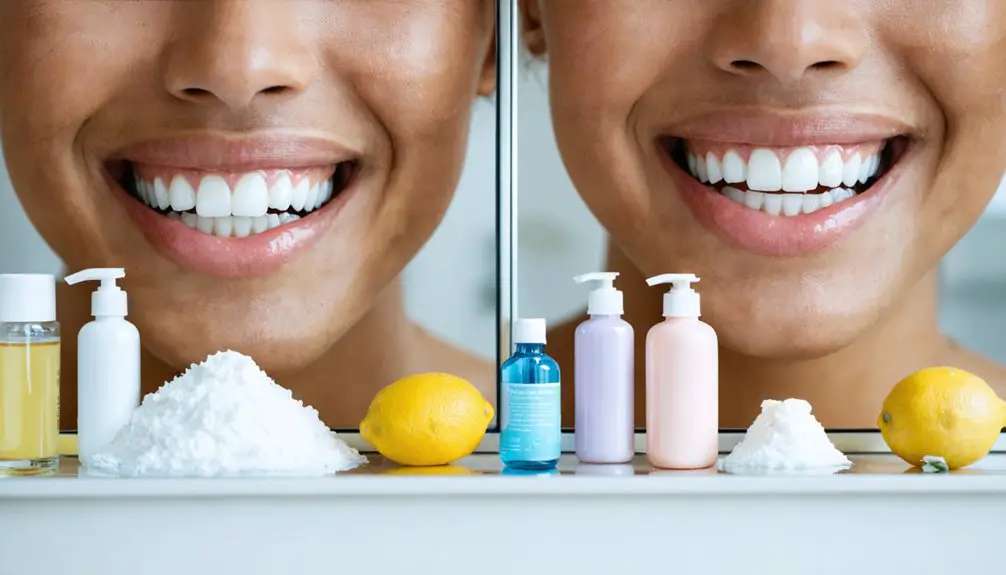
While you’ll receive expert monitoring and customized protection during professional whitening treatments, DIY methods leave you vulnerable to risks from improper application and uneven results.
Your investment in professional treatment typically yields more dramatic, longer-lasting results that can persist for 2-3 years with proper maintenance, compared to the shorter-term effects of DIY products.
Though DIY options cost considerably less upfront ($10-$50 versus $300-$1,000 for professional care), the potential dental complications from unsupervised whitening could lead to costly remedial treatments.
Safety Under Expert Supervision
Despite the allure of DIY teeth whitening solutions, professional dental supervision offers superior safety and efficacy in achieving a brighter smile. With expert oversight, you’ll benefit from carefully controlled peroxide concentrations and treatment customization tailored to your specific needs.
Professional whitening treatments provide:
- Precise application techniques that minimize enamel damage while maximizing whitening effectiveness
- Incorporation of desensitizing agents to reduce tooth sensitivity and discomfort
- Careful monitoring of gum tissue to prevent irritation and adverse reactions
- Controlled exposure times to avoid over-bleaching and potential tissue damage
Research confirms that professionally supervised treatments using up to 35% hydrogen peroxide maintain enamel integrity better than DIY alternatives.
You’ll receive immediate intervention if sensitivity occurs, ensuring both your comfort and ideal results throughout the whitening process.
Long-Term Results Compare
Professional teeth whitening consistently outperforms DIY methods in both immediate and long-term results.
You’ll achieve up to 8 shades lighter in a single professional session, compared to just 2-6 shades with DIY approaches. The long lasting effects of professional treatments typically extend 1-3 years with proper whitening maintenance, while DIY methods require frequent touch-ups.
Professional treatments use 25-40% peroxide concentrations that penetrate deeper into your enamel, creating more sustainable results than DIY products’ 3-10% solutions.
You’ll also benefit from customized trays and expert application techniques that guarantee uniform whitening across all teeth surfaces.
For complex stains like tetracycline or fluorosis, only professional treatments can effectively address these challenges, as DIY methods often fall short in treating intrinsic discoloration.
Cost Versus Health Benefits
Considering the substantial cost difference between treatment options, you’ll need to weigh the long-term value against immediate savings when choosing between professional and DIY teeth whitening.
A thorough cost analysis reveals that professional treatments offer superior health investment value despite higher upfront costs.
Consider these critical factors:
- Professional treatments achieve 4-8 shade improvements in just 1-2 hours, while DIY methods require weeks for 1-2 shades.
- Supervised treatments include gum protection and sensitivity management, preventing costly dental repairs.
- Professional methods effectively address both surface and deep stains, reducing the need for repeated treatments.
- DIY product overuse often leads to uneven results and enamel damage, requiring professional intervention that increases overall costs.
Frequently Asked Questions
How Soon After Professional Dental Work Can I Start DIY Teeth Whitening?
You’ll need to wait 2-4 weeks after most dental work before starting DIY teeth whitening. Consult your dentist for a specific timeline based on your procedure’s requirements.
Can Pregnant or Nursing Mothers Safely Use At-Home Teeth Whitening Products?
You shouldn’t use teeth whitening products during pregnancy due to safety concerns. While nursing concerns are fewer, it’s best to consult your healthcare provider before starting any whitening treatment.
Will DIY Teeth Whitening Affect the Strength of Existing Dental Bonding Materials?
Yes, DIY whitening products can weaken your bonding material durability through chemical interactions. You’ll risk compromising existing dental work, so consult your dentist before attempting any whitening product interactions.
How Long Should I Wait Between Different DIY Whitening Treatment Methods?
With 45% of users experiencing sensitivity, you’ll need to wait 1-2 weeks between different DIY treatment methods. Follow safety guidelines and monitor your teeth’s response to avoid exceeding recommended treatment frequency.
Are Natural Teeth Whitening Alternatives Like Charcoal and Baking Soda Completely Safe?
No, they’re not completely safe. Charcoal’s high abrasiveness can permanently damage your enamel, while baking soda’s effectiveness is limited and can harm teeth if used too frequently or aggressively.
References
- https://www.richardfossumdds.com/blog/what-are-the-dangers-of-diy-teeth-whitening/
- https://www.mydental.com/the-dangers-of-diy-teeth-whitening-critical-information-to-know/
- https://www.glendaleheightsfamilydental.com/blogs/diy-teeth-whitening-risks
- https://www.smileklubdental.com/teeth-whitening-gone-wrong-heres-what-you-should-know-before-you-try-it-at-home/
- https://health.clevelandclinic.org/is-teeth-whitening-safe
- https://bestsmilesdentist.com/can-teeth-whitening-damage-your-enamel/
- https://www.soladentalspa.com/blog/can-teeth-whitening-cause-damage-to-your-enamel
- https://pmc.ncbi.nlm.nih.gov/articles/PMC4058574/
- https://www.eastridgedentalgreenbay.com/teeth-whitening-cause-enamel-loss/
- https://adanews.ada.org/huddles/risks-of-frequent-teeth-whitening/
